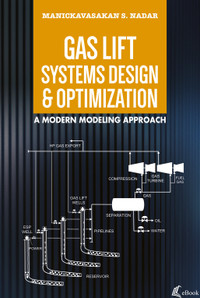Description
Gas lifting can be used throughout the whole lifespan of an oil well: from the time it dies until its abandonment. The Gas Lift Manual is a handbook of theories and practices that offers a complete review of gas lift technology. The first book devoted to gas lifting since K. Brown's Gas Lift Theory and Practice published in 1967, it serves as a reference that is essential to the practicing engineer needing to successfully perform this type of artificial lift project. In his manual, Takacs imparts more than 30 years' experience and research in the artificial lift methods arena. It includes practical advice on the analysis and troubleshooting of gas lift installations. All necessary calculations are fully discussed, and the many charts in the appendices are intended to help field engineers.
The manual starts the with an introduction to gas lift, and then moves on to the various parts of the gas lift model, including analysis and troubleshooting, as well as, common gas lift malfunctions. The pressure drop calculation procedures for vertical, inclined, and horizontal wells including the latest mechanistic models are fully described. The chapter on production engineering fundamentals includes, in addition to a very detailed treatment of multiphase flow, a review of fluid properties, well inflow performance, basic hydraulics, well temperature, and systems analysis. Further chapters systematically introduce the reader to the hardware of gas lifting, reflecting the latest developments in gas lift valve and other equipment designs. A chapter on continuous flow gas lift fully describes the different ways to optimize the wells' operation, including the latest optimization theories (lift gas allocation to wells, systems analysis, etc.). The discussion of intermittent gas lift includes conventional, chamber, and plunger-assisted installations and describes the performance, design, and optimization of such wells. A detailed treatment of the surface gas lift system follows, including the operation and design of the complete system consisting of the compressor station, and the distribution and gathering facilities. This book will be particularly useful to those needing to research this technology, as the author has supplied extensive resource references to other literature sources.
Features and Benefits
- A handy single-source reference
- Includes extensive references for further research
- Ample illustrations help the reader understand the text
Audience
- Engineers
- Management
- Students
About the Author
Dr. Gabor Takacs is a professor and Head of the Petroleum Engineering Department at the University of Miskolc, Hungary and holds MS and PhD degrees in Petroleum Engineering from the same institution. He has more than 30 years of teaching and consulting experience in the production engineering field. He taught as Visiting Professor at Texas Tech University, USA in 1988/89 and at the Mining University of Leoben, Austria in 1995. In 1995/96 he was selected SPE Distinguished Lecturer, was Outstanding Technical Editor for the SPE journal Production and Facilities 1992-2003 and chaired the Artificial Lift TIG of SPE in 1997-2003. Dr. Takacs authored the books Modern Sucker-Rod Pumping and Sucker-Rod Pumping Manual, both published by PennWell Books, and more than 80 technical papers. Dr. Takacs is a well-known consultant and instructor on production engineering and artificial lift topics. Also available by Gabor Takacs, PhD: Sucker-Rod Pumping Manual
Details
Type: Hardcover
Size: 8.5x11
Pages: 476
Published: 2005
ISBN: 9780878148059
Please download the errata sheet here.






